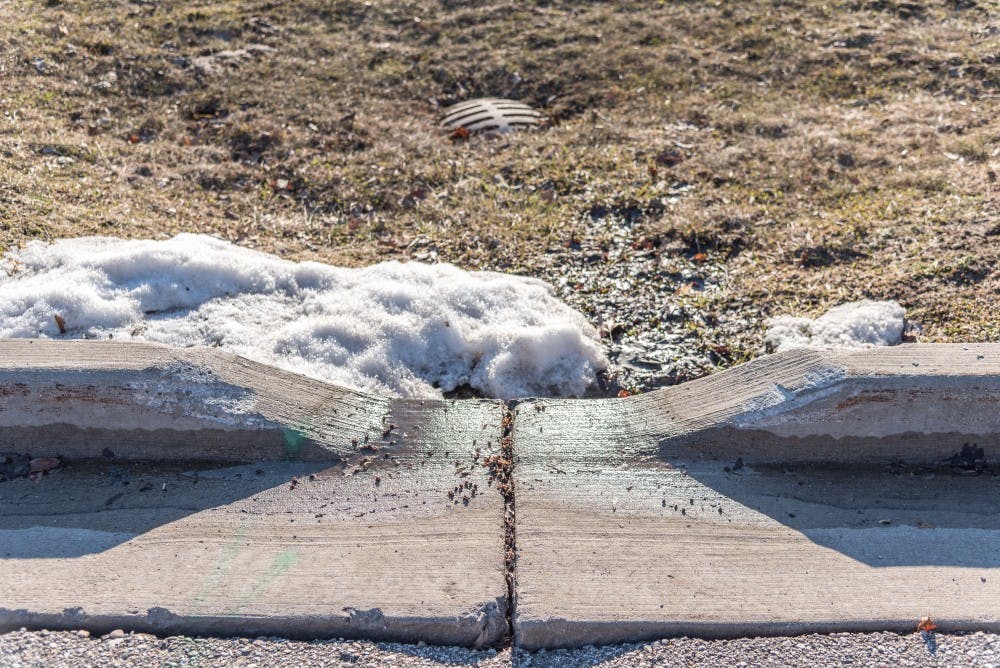Storm drain project to raise awareness about water conservation

A storm drain collects stormwater runoff from N Island Park Drive March 22 at Island Park, 331 N Main St.
A new project will give Island Park storm drains a makeover at the Chippewa Riverwater Festival to help inhibit the contamination of Mount Pleasant waterways.
The annual festival, happening noon to 6 p.m. July 13, is a free event, featuring Michigan musicians, storytellers and speakers. The event's purpose is promoting water conservation, environmental education and the Chippewa River, said Taylor Brook, a Watershed Outreach Coordinator for the Saginaw Chippewa Indian Tribe.
"This project is meant to raise awareness for the fact the water that goes in these storm drains is not treated and goes straight into the river," Brook said. "I want to educate people to make more conscious decisions."
Brook, whose job is educating and raising tribal and external awareness about water conservation, is currently looking into using eco-friendly paints for the project. Since there are some unknowns, Brook said storm drains will be painted with stencils, making them easier to maintain.
If the project succeeds, Brook said she will begin looking into utilizing local artists. Chosen artists would be permitted to decorate storm drains with free-form paintings and murals.
"The Chippewa River has a decent amount of pollution in it," Brook said. "However, it is not because Mount Pleasant has no care for its waterways. It is because people do not necessarily understand the impact they have on the river."
Brook does not foresee a problem receiving funds and supplies and hopes to receive them through donations and the Great Lake Restoration Initiative.
The project was inspired by Dayton, Ohio's "Storm Drain Artscapes."
"The unique, beautiful public art adds to the vibrancy of downtown streetscapes," Katie Norris, an environmental scientist for Dayton, said of the city's painted storm drains. "Storm drains are an important city infrastructure, and are often invisible to many citizens who do not notice or understand their importance. However, these drains are critical to the functioning of our city and impact the health of our rivers."
Before storm drains were painted in 2015, Norris had safety and educational training for artists. Norris said the murals were well-received by Dayton and a scavenger hunt was held for citizens to find all nine murals.
Like Dayton, Mount Pleasant's stormwater system drains directly from city streets, parking lots and lawns to the river.
The city has two sewer systems — the stormwater system and a wastewater system. The stormwater system is designed to carry runoff and other drainage to the Chippewa River. The wastewater system is designed for residential and commercial sanitary sewage, which is later treated at the Mount Pleasant Wastewater Treatment Plant (WWTP).
"Some people are oblivious to the fact that the mop water or paint they dump down the storm drain instead of in their kitchen sink won't go to the (WWTP)," said John Zang, director of Public Works.
Pollutants like grease, oil, anti-freeze and salt can all be hazardous to fish, birds and other wildlife who rely on the Chippewa River for sustenance.
Raising awareness around water conservation is more important now than any other part of the year, Brook said, as salts and other contaminates reach the Chippewa River due to runoff.
At a Feb. 11 Mount Pleasant City Commission meeting, Commissioner Tony Kulick said throughout the winter Mount Pleasant receives comments requesting the city put more salt on its streets. Putting more salt on the roads can have negative side-effects in the Spring as contaminated storm waters enter the river, Kulick said.
Brook said Mount Pleasant water quality programs monitor for hazardous chemicals. In their research, they found many more contaminants in the spring and summer months. Brook described the lack of water conservation as an "emerging issue," especially among homeowners
Zang said the city is aware of the affects road salt can have in the spring and does its best to limit the use of salt.






